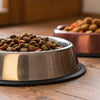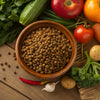How Many Cups in a Pound of Dog Food Dry: A Comprehensive Guide for Pet Owners
- Houndsy
Table of Contents
- Introduction
- Understanding Dog Food Measurements
- Measuring Dog Food Accurately
- Calculating Cups for Different Bag Sizes
- The Role of Consistent Feeding Practices
- Houndsy Kibble Dispenser: Elevating the Feeding Experience
- Conclusion
- FAQs
Introduction
As devoted pet owners, we all want to ensure our furry companions receive the right amount of food to maintain their health and energy levels. However, when it comes to measuring dog food, many of us find ourselves asking, "How many cups are in a pound of dog food dry?" This question is not just a matter of curiosity—it's crucial for managing your dog's diet. A common guideline suggests that there are approximately four cups in a pound of dry dog food, but this can vary based on the specific type of kibble and its density.
In this post, we'll delve into the intricacies of dog food measurements, helping you understand the volume-to-weight ratio and why it matters for your pet's well-being. We also aim to simplify your dog-feeding routine by providing practical insights and actionable strategies for consistent portion control.
By the end of this article, you'll have a clearer understanding of how to measure your dog's food accurately and how the Houndsy Kibble Dispenser can elevate your feeding experience. We invite you to reflect on your current pet feeding practices and consider how small adjustments can lead to healthier habits for both you and your pet.
Understanding Dog Food Measurements
When navigating the world of dog food, it’s essential to recognize that measurements can be confusing. Dog food is often labeled in pounds, but feeding recommendations are typically provided in cups. This duality can lead to misunderstandings about how much to feed our dogs.
The Volume-to-Weight Ratio
The key to answering the question of how many cups are in a pound of dog food lies in understanding the volume-to-weight ratio. Generally, most dry dog foods will have around four cups per pound. This means that if you have a 30-pound bag of kibble, you’d expect it to yield approximately 120 cups of food. However, this is a general guideline; the actual number can vary based on the kibble's size and density.
To put it simply, the formula for calculating the number of cups in dog food is:
Number of Cups = Weight of Dog Food (in pounds) x 4 (cups per pound)
For instance, a 15-pound bag of dog food would contain around 60 cups (15 lbs x 4 cups/lb = 60 cups).
Factors Affecting Dog Food Density
Several factors can influence how many cups are in a pound of dog food:
- Kibble Size and Shape: Smaller, denser kibble may yield more cups per pound compared to larger, irregular pieces.
- Ingredients: Foods high in denser ingredients (like meat) may weigh more, affecting the volume measurement.
- Moisture Content: Dry kibble tends to provide more cups per pound than moist or semi-moist foods, which contain more water.
Understanding these factors allows us to make better-informed decisions regarding our pets’ diets.
Measuring Dog Food Accurately
Accurate measurement of dog food is critical for maintaining your pet's health. Too much or too little can lead to various health issues, including obesity or malnutrition. Here are some effective strategies to ensure you are measuring dog food correctly.
Tools for Accurate Measurement
- Measuring Cups: Use a dedicated measuring cup for dog food to ensure consistency. Standard measuring cups typically hold about 8 ounces of volume.
- Kitchen Scale: For those looking for precision, weighing your dog food can eliminate any guesswork. This method is particularly helpful if you're following a strict dietary plan for your pet.
Recommended Feeding Guidelines
Feeding recommendations can usually be found on the dog food packaging. They often specify portion sizes based on your dog's weight, age, and activity level. It’s essential to follow these guidelines closely, adjusting as needed based on your dog’s individual needs.
The Impact of Regular Feeding Routines
Establishing a consistent feeding schedule significantly benefits your dog’s health. Regular meal times help with digestion and provide a sense of security for your pet. By measuring food accurately and sticking to a routine, we can promote better digestion and metabolism in our canine companions.
Calculating Cups for Different Bag Sizes
To help you visualize how many cups are in various bag sizes, we’ve created a quick reference guide based on the general rule of four cups per pound.
| Bag Size (lbs) | Approximate Cups |
|---|---|
| 5 lbs | 20 cups |
| 10 lbs | 40 cups |
| 15 lbs | 60 cups |
| 25 lbs | 100 cups |
| 30 lbs | 120 cups |
| 40 lbs | 160 cups |
This table provides an easy reference for pet owners to quickly determine how much food they can expect from different bag sizes.
The Role of Consistent Feeding Practices
Adhering to precise portion sizes is essential for a well-balanced diet. Overfeeding can lead to obesity and associated health risks, while underfeeding can result in nutritional deficiencies.
Benefits of Consistent Feeding
- Weight Management: Maintaining a healthy weight prevents numerous health issues.
- Improved Digestion: Regular meal times contribute to better digestion and metabolism.
- Routine: Pets thrive on routine. A consistent feeding schedule provides a sense of security.
By integrating these practices into our daily routines, we can ensure our dogs remain healthy and happy.
Houndsy Kibble Dispenser: Elevating the Feeding Experience
At Houndsy, we understand that the feeding ritual is an integral part of your pet's routine. Our flagship product, the Houndsy Kibble Dispenser, was designed to enhance this experience with features that embody our commitment to convenience, design excellence, and pet well-being.
Key Features of the Houndsy Kibble Dispenser
- Convenient Crank Operation: Positioned at standing height, our dispenser eliminates the need for bending, making the feeding process easier for you.
- Perfect Portion Control: Our dispenser delivers the ideal amount of food every time, ensuring your pet receives the correct portion without the guesswork.
- Mid-Century Modern Design: Not only does the dispenser work flawlessly, but its stylish design also complements your home decor.
- Safety Features: The auto-locking mechanism prevents accidental dispensing by curious pets or toddlers, ensuring that feeding is safe and mess-free.
With a capacity of 25-30 lbs, our dispenser is made with high-quality, BPA-free materials to keep your pet’s food fresh.
For those looking to elevate their dog-feeding experience, we invite you to explore the Houndsy Kibble Dispenser and see the difference it can make in your daily routine.
Conclusion
Understanding how many cups are in a pound of dog food dry is essential for maintaining your pet's health and ensuring that you are feeding them the right amount of food. By using the general guideline of four cups per pound, along with accurate measuring tools and consistent feeding practices, we can provide our dogs with the nutrition they need.
As we strive to simplify and elevate the dog-feeding experience, the Houndsy Kibble Dispenser stands out as an innovative solution for design-conscious pet owners. We encourage you to reflect on your own feeding practices and consider how the right tools can enhance your pet's mealtime.
FAQs
1. How many cups are in a pound of dry dog food?
Typically, there are about four cups in a pound of dry dog food. However, this can vary based on the size and density of the kibble.
2. How do I calculate the number of cups in a bag of dog food?
To calculate the number of cups in a bag of dog food, multiply the weight of the bag (in pounds) by four. For example, a 30-pound bag would yield approximately 120 cups (30 lbs x 4 cups/lb).
3. Why is measuring dog food important?
Accurate measurement ensures your dog receives the correct portion of food, which is crucial for maintaining a healthy weight and preventing health issues.
4. Can I use regular kitchen cups for measuring dog food?
While you can use regular kitchen cups, it’s best to use dedicated measuring cups for dog food to maintain consistency and avoid confusion.
5. How does the Houndsy Kibble Dispenser help with feeding?
The Houndsy Kibble Dispenser offers convenient, precise portion control, and its stylish design fits seamlessly into modern home decor, making it a practical and attractive choice for pet owners.
Explore how the Houndsy Kibble Dispenser can transform your feeding routine today—Order Now!












